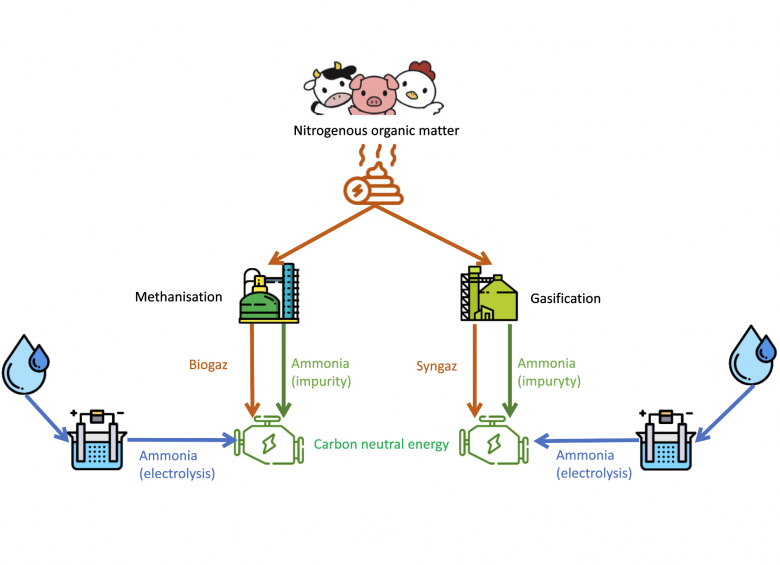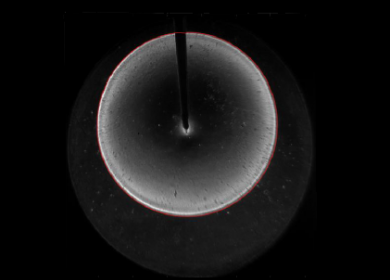Ammonia-SYNgaz or BIOgaZ mixture to achieve decarbonization in 2050
| Exploratory project of the CNRS Energy unit | |
| Duration ► | 12 months |
| Start ► | January 2022 |
Context
Following the Green Deal, the European Commission has announced its objective of achieving carbon neutrality by 2050. All sectors will be concerned: from transport to energy, including the industrial sector. To do this, the share of renewable sources in the energy mix is envisaged at 40%, whether directly by green and renewable energies (wind, solar, etc.) or biomass and waste fuels, another solution for carbon capture, storage and use. However, the green and renewable energies intermittency, as well as the need to maintain a secure electricity supply, requires the ability to store excess energy during periods of low demand. One of the possible storage ways is electrochemical storage through molecules such as hydrogen and ammonia. Ammonia is an interesting alternative because it has many advantages over hydrogen: lower cost per unit of stored energy, greater energy density by volume, large production and distribution network, stored liquid at only 9 bar at ambient temperature.
Currently, ammonia is mainly considered in mixture with conventional fuels (coal gas, gasoline, natural gas) to reduce the industrial processes carbon footprint. Indeed, because of its very high auto-ignition temperature and its low flame speed, it remains difficult to control in terms of energy performance and emissions.
When it comes to biomass produced fuels, the two most common routes are methanation and gasification. Methanisation is an anaerobic digestion process at 40°C that mainly produces methane and CO2 in proportions that generally vary little. Gasification is a process for the thermal conversion of biomass into syngas containing mainly hydrogen (H2), carbon monoxide (CO), methane (CH4), nitrogen (N2) and carbon dioxide (CO2).
Depending on the type of process, for example hydrothermal (375-500°C) or pyro-gasification (800–1000°C), gasifier (fluidized or fixed bed), the parameters (temperature, heating rate, richness) or even the raw material, the composition of the SYNgas can vary greatly, not only from one installation to another but also over time for the same installation. The table below presents as an example three compositions of syngas from different raw materials (stones and fruit residues) with the same gasifier.
| Biomass | Reactor temperature (°C) | %H2 | %CO | %CH4 | %CO2 | %N2 |
| Olive | 800 | 16.58 | 23.06 | 3.41 | 4.66 | 52.29 |
| Peach | 700 | 12.14 | 19.96 | 10.72 | 5.27 | 51.91 |
| Grape | 800 | 18.63 | 16.94 | 2.02 | 6.02 | 56.39 |
The use of syngas in combustion therefore still represents a challenge since this great variability of composition will impact the combustion fundamental properties and therefore the industrial applications performance. One of the fundamental parameters in these processes is the laminar flame velocity which remains difficult to predict due to the great variability in the syngas composition, which results from a large number of factors related to its production process. Prediction becomes all the more difficult if ammonia is added to the mixture due to its particular combustion properties. Until now, work around syngas flame velocity has mainly focused on H2/CO mixtures and sometimes with an additional compound such as methane or a diluent, N2 or CO2. Two recent exceptions are noteworthy with measurements of laminar flame velocities for "full" or "true" syngas compositions representative of three types of gasifier.
Recently, some studies have focused on NH3/Syngas flame velocity measurements and the development of reaction mechanisms but again, they focus on simple syngas mixtures: H2/CO or even on the impact of each of these 2 components taken separately. Non-linear behaviors on the flame speed for NH3/CO mixtures should also be noted. There is therefore always the question of the impact of a "real" syngas composition on the flame speed but also on the reaction paths since each of the components of the syngas could have a different contribution according to its proportion in The mixture. In addition, few works mention the impact on stretch sensitivity of these mixtures: Markstein length, Lewis number.
Moreover, looking at complete syngas compositions can be of interest for NOX. Indeed, since syngas is naturally highly diluted, its combustion temperature is low and could make it possible to maintain a low level of thermal NO emission on the applications. With regard to biogas (CH4/CO2), the work of Okafor & al. made it possible to investigate the flame speeds and kinetics of NH3/CH4 mixtures. However, the effect of CO2 remains to be investigated: simple diluent or actor in chemistry.
Objectives
This project objectives are to study the fundamental combustion properties of NH3/syngas and NH3/biogas mixtures, namely laminar flame velocity and sensitivity to stretching in a first step.
The project will aim in particular to quantify the effect of the proportion of ammonia or bio/syngas in the mixture but also of the variability of syngas composition currently little considered in the current literature. The main difficulty will be to ensure a homogeneous mixture of the whole and to have a repr.esentativeness of the syngas compositions.
The project will also make it possible to explore the phenomena of combustion instabilities inherent in ammonia and syngas: gravitational or even hydrodynamic for mixtures depending on the H2 content. These instabilities identification, even in a spherical configuration, is important for the correct measurement of the flame speed but also with a view to use on a burner.
The dependence on the initial conditions (pressure and temperature simultaneously, done separately in the studies currently available) will then be studied.
Finally, the analysis of the reaction paths and their sensitivity will be carried out, but represents a challenge due to the number of components and requires a robust mechanism containing all the syngas species (no specific dedicated mechanism currently available).
Work Plan
The project is composed of 3 tasks organized as follows:
Task 1 : Laminar flame velocity measurement at constant pressure.
In a laminar spherical combustion enclosure, a laminar flame velocity measurement campaign at constant pressure and Markstein lengths for a single initial condition of pressure and temperature will be carried out. For different syngas compositions (3 typical compositions envisaged) a biogas composition (for reference), a scan of the NH3 quantity in the mixture will be carried out. Measurements will be made for different richness ensuring stability from lean to rich mixture.
Task2 : Flame velocity temperature and pressure dependence determination
A second spherical combustion chamber will be used to carry out measurements at constant volume. This will allow the determination of the temperature and pressure dependence coefficients of the flame velocity over a wide range of conditions. The effect of composition and mixture on these coefficients will also be studied.
Task 3 : Identification of reaction mechanism and sensitivity analysis.
The objective of this task is first of all to carry out a bibliographic study on the kinetic mechanisms containing all the species considered or even to create a new one from existing mechanisms. Flame speed simulations will be carried out for comparison with the experimental results obtained on the two enclosures.
For a given condition, a sensitivity analysis of the mechanisms on the flame speed will be carried out according to the NH3 content and the composition of the syngas in order to determine the preponderant reactions according to the mixture and the composition. From this work, avenues for improving mechanisms can be proposed.
Expected results
In terms of impact, the results obtained will allow the publication of an article in a journal such as Combustion and Flame, Fuel, or even Energy & Fuels with also a dissemination on HAL of a preliminary version for open access communication of the results.
In addition, this project could provide a kinetic mechanism for these mixtures (at least initiate its development) allowing use in CFD numerical simulation.
Finally, this initial work could be the start of experiments closer to applications: on a thermal converter or burner for example in order to explore the NOX and N2O emissions of these systems for NH3/bio-syngas mixtures. This exploratory project is aiming to submit an ANR within the framework of the 2023 generic call for projects or to respond to the priority equipment program for exploratory research.
Contact : Pierre BREQUIGNY ⇒ pierre.brequigny@univ-orleans.fr



